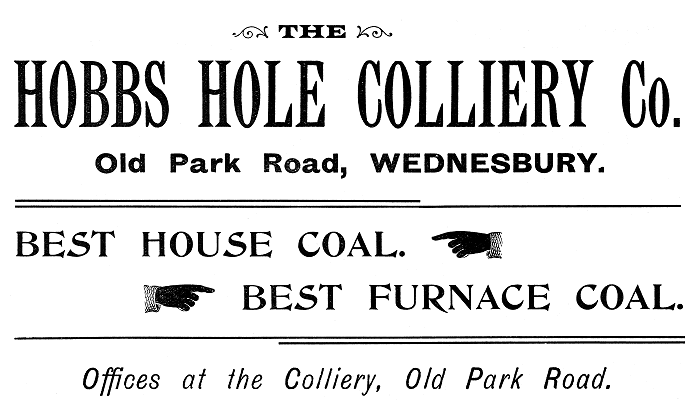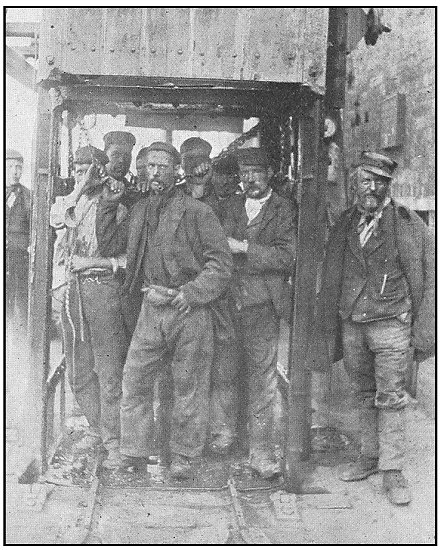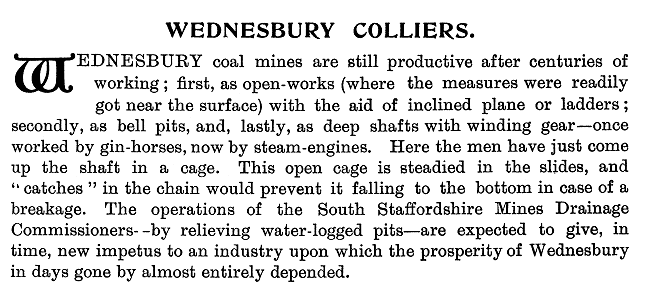|
Another underground fire started at
Sparrows Forge Road in 1902 which resulted in a crowning
in. A similar fire broke out behind the Old Park Works
in 1911 which resulted in a horse being swallowed up. As
recently as June 1935 another underground fire took
place in Old Park Road.
Lodge
Holes Colliery, like many of the local coal mines,
caused subsidence in the surrounding area. Some of the tunnels in the coal mine were
under Dangerfield Lane, which caused part of the road to
subside. Wednesbury Corporation was left with the job of
restoring the road to its original level to make it
useable again. On the 30th June, 1908, the Corporation
sought damages from the colliery owners to cover the
cost of the repairs to the road, including raising it to
its original level. The owners had refused to cover the
full cost, stating that it would be far cheaper to
repair the road, leaving it at the sunken level.
Wednesbury
Corporation went to the Court of Appeal in the Royal
Courts of Justice to force the colliery owners to pay
the full amount for the necessary work. The Corporation
were unsuccessful in their appeal and were told that the
sum of £80 offered by the colliery owners would be
sufficient. In order to restore the road to its original
level and to properly support it, involved the building
of an embankment and retaining walls, which cost the
Corporation around £400. Details of some of the local mines
can be seen in the list compiled in 1896 by W. Beattie
Scott, H.M. Inspector for the South Stafford District:
|
Mine |
Owner |
Underground workers |
Surface workers |
|
Blakeley Wood |
Price and Son, Leabrook |
38 |
26 |
| Coal
Hall
|
David Read, Darlaston Road |
|
|
| Far
Close |
Roberts and Parkes,
Wednesbury Bridge |
|
|
| Hobbs
Hole |
Hobbs Hole Colliery Co. |
12 |
5 |
|
Hollow Meadow
|
Smith, Round & Ramsall,
Hollow Meadow |
|
|
| Lodge
Holes |
Wednesbury Henry
Bird, Butcroft, Darlaston |
5 |
3 |
|
Millfield |
Patent Shaft and Axletree
Co. |
114 |
76 |
|
Moorcroft |
Moorcroft Colliery Co.,
Moxley |
20 |
7 |
|
Moorcroft |
G.W. Bray, Moxley |
5 |
3 |
| Old
Park Road |
Hobbs Hole Colliery Co.,
Wednesbury |
16 |
5 |
|
Wednesbury, Old Fields |
Bradshaw and Bailey, West
Bromwich |
3 |
2 |
|
Wednesbury, Old Park |
Jas. and Jno. Hunt, King's
Hill |
13 |
4 |
At Old Park
Colliery, run by Lloyds and Fosters, they raised coal
from a depth of 200ft, most of which was used in the Old
Park Works. Other mines were run by:
|
Samual Addison
|
|
John Bagnall & Sons |
|
Simeon Constable |
|
Danks & Company |
|
Edward Wright & Company |
Coal mining in the town began to
decline in the second half of the 19th century, at a
time when coal could easily be transported from other
areas, thanks to the extensive transport infrastructure.
The main competition came from the Cannock area, and the
following neighbouring towns:
|
Town |
Number of collieries |
|
Bilston |
64 |
|
Walsall |
39 |
| West
Bromwich |
52 |
|
Wolverhampton |
26 |
The collieries in West Bromwich were all built during
the 19th century. At the time there were 21 working pits
in Wednesbury, including Balls Hill Colliery, run by
Lloyds and Fosters, and Lion Colliery at the Mounts.
Both of them were producing the best coking coal in
Staffordshire for the iron smelters and the gas
companies.

An advert from 1897.
By the end of the 19th
century, only a few pits survived, and within a short
time they too would disappear as they became
uneconomical to work. The last were the Millpool
Colliery which closed in 1914, and the Millfield
Colliery which closed in 1915. Both were owned by the
Patent Shaft.
An interesting account of local
coal mining can be found in "Osborne's Guide to the
Grand Junction Railway" published in 1838:
Wednesbury is about a mile and a
half to the west of the line, and two miles further
north than West Bromwich. It was, very early in the
history of our country, a place of importance; its name
being derived from Woden, the God of war of the Saxons,
and Boro or Burgo, the name of a town. In the year 900,
there was a strong fortress erected here, on the hill
where the church stands now. The place stands on a hill,
and is surrounded by the scenery of tall chimneys,
engine houses, the machinery of coal pits, furnaces, and
iron works. It is a dark, dirty, mean-looking place, as
though cleanliness and comfort were none of its care.
The population is 9,000 or more. The church is a
handsome Gothic building, lately repaired at an expense
of £5,000. The living is a vicarage, in gift of the
crown. There are three chapels. One belonging to
the Independents, one belonging to the Methodists, and
one to the Primitive Methodists. This is one of the
places that furnished such furious mobs, when first the
Wesleyans began their out-door preaching.
There is a Lancasterian School,
built by subscription, for educating 130 boys, a Church
Sunday School, and a Methodist School. There are about
£68 per annum arising from land and legacies, for
charitable purposes: and the Poor Rates amount to more
than £2,300.
The mines of coal, iron, and
lime, and the manufacture of iron into gun locks and
barrels, axle-trees and springs for coaches, hinges,
nails, screws, files, gas and water tubing, afford the
population tolerably full employment. The whole country
round about seems turned inside out: it is worked in all
directions for ironstone, coal, and limestone.
The pits vary in depth from 60
to 300 yards. It is extremely interesting to go down one
of these pits; and if the visitor resolves to descending
one, he had better select one that is deep, and has been
in work for some time. He will be furnished with a
miner's jacket, trousers, and cap, and accompanied by a
guide, and will get into a large iron basket fastened by
hooks and chains to the rope, the iron basket resting on
the lid of the pit. The rope is gently drawn up, and the
lid rolled away, when the experimenter finds himself
suspended over a perpendicular descent of 200 yards. The
engine begins to turn, and he descends into the shaft,
which becomes increasingly dark, and the candle which he
carries with him scarcely serves to light him to see the
moving darkness. As he passes down, he will observe the
different strata, and most probably will see the
openings of mines which have been worked in the course
of the sinking of the pit. The sensation which he will
experience, from the sides of the pit rapidly ascending
past him, while he feels himself as rapidly sinking, is
one which is very awful and interesting, and must be
experienced to be understood. To feel that you are fast
sinking into the bowels of the earth, and that the light
of heaven and the beauty of earth are receding from you,
and may never more appear, is one of those sensations
which brings all the natural dread of eternity nearer to
us than we probably ever experienced before. On arriving
at the bottom, you step out, and following your guide,
you discover some dim shadowy beings, by means of the
lights placed around, who are engaged in boring and
digging the solid rock.
But now you turn your eyes up to
look what is the roof over your head: and there you see
the massive and eternal rock, and remember that you are
two hundred yards beneath the surface of the earth. What
a situation would it be for one being alone! On looking
round, you perceive (if it be a limestone pit,) a lofty
roof, eight or ten yards high, of apparently veined
marble, sustained by massive and handsomely formed
pillars, at the distance of every ten or twelve yards.
These pillars are parts of the rock, which have been
left in the working, and yet they have all the
appearance of having been constructed. In some places
you see men lying down, working with pick axes, clearing
away the obstructions; in others you see them boring the
rock by driving immense chisels into it; and in some
places you see them upon ladders, doing the same work at
the roof. Anon they inform you they are going to blast a
portion of the stone off. You retire behind a pillar,
and the terrific explosion thunders in reverberating
volleys through the mine. Again and again does the blast
burst in astonishment upon your ears. On examining the
place after an explosion, you find a large mass of rock
split off, sometimes a ton in weight. Such is the power
of the expansion of heated air.
In some places you find the
water drains through the rock into the mine; and the
mouth of the pit is always dropping, so that the mine
would soon be full of water, if it were not for the pump
which is always kept at work in the other shaft. The air
is very agreeable, and when the eye is accustomed to the
dullness of the light, and can distinguish clearly what
is going on, the mine is really very pleasant; for the
temperature is quite comfortable, and all the fear of
your position is gone in the course of half an hour.
After seeing the loading of the basket occasionally, you
at length step in yourself and ascend, returning to the
surface of the earth again.
It is lamentable to find, that
this population scarcely ever thinks of anything but
eating and drinking when the day's labour is over. The
house of the working man is not much inhabited by him.
The mine has his days, and the ale-house his evenings.
He cares not for his family. The wife may care if she
will; but she was brought up in a house of the same
kind, and what else can be expected of her.
The women in this neighbourhood
seldom wear caps. They mostly use a handkerchief tied
round their head, and neither in person or manner show
much of grace, or attraction. They are early used to
carry heavy burdens, and help to load and unload at the
mouth of the pit; hence they become coarse and unwieldy,
and lose that natural pleasantness, if not gracefulness
of appearance, which is common to their sex. This is
particularly observable in the extreme width of their
mouths, shortness of the necks, and breadth of their
shoulders, caused by the habit of carrying heavy baskets
of coal on their heads from the shafts of the pits to
their respective dwellings, there being a regular
allowance to each workman for his individual home
consumption.
There is a market every Friday,
and a fair on the 6th of May, and the 3rd of August.
There is also a wake or feast, which begins on the
Sunday before Bartholomew's day. The wake, especially,
is a terrible time for the display of the propensity to
drunkenness. During the war most of the men might have
become independent, so high were their wages, and so
constant was their employ; but after all, few of them
are possessed of common necessaries.
|


From the 1900 edition of
Ryder's Annual. |
|
Other Industries
The Quarter Session Rolls from
around the end of the 16th century includes a
list of the inhabitants of Wednesbury who ended up in
court. It also includes their occupations which were:
| alehouse keeper,
baker, blacksmith, bridle / saddle maker,
buckle maker, butcher, carrier, draper,
farmer, ironmonger, iron worker, joiner,
labourer, miller, nailer, peddler or
merchant, potter, servant, spur maker,
weaver |
The burials recorded in the Parish
Registers from 1678 to 1699 include the occupations of
the deceased as follows:
| 2 bakers, 3
blacksmiths, 7 brick makers, 3 buckle
makers, 3 butchers, 6 carpenters and
joiners, |
| 3 cobblers, 73
colliers, 2 edge tool makers, 5 farmers, 2
glove makers, 2 iron fitters, |
| 2 ironmongers, 10 labourers, 4 locksmiths, 1
maltster, 3 masons, 6 millers, 83 nailers, |
| 2 peddlers or merchants, 8 potters, 2
servants, 2 textile dealers, 3 weavers, 1
wheelwright |
It is interesting to compare the numbers of people
involved in the different industries listed in the above
table. Most of the workers were nail makers or coal
miners, showing the importance of both of the industries
at the time. Nearly 3% of the working population were
brick makers, and 3.4% were potters. The local pottery
became known as "Wedgebury ware" and was sold throughout
the region.
Clay tobacco pipes were also made using white clay from
Monway Field.
In 1776 Wednesbury had its own silversmith in the
form of John Whitehouse who produced many items
including buckles, seals and tea tongs.
Pottery
Pottery was one of the town’s
earliest industries. It dates back to at least the early
1400s. Two potters, Geoffery Mosard and Thomas Brerely
are mentioned in 1422 as defendants in a case, listed in
a deed from 1423, that’s in the William Salt Library.
The industry is also mentioned by Robert Plot in his
‘Natural History of Staffordshire’ published in 1686. He
wrote that there were two kinds of clay dug in Monway
Field, on the west side of the town, that were used in
combination to make pottery that was painted with a slip
made from a reddish earth found at Tipton. One type of
clay was a yellowish colour that was mixed with white
clay, which was stiff and weighty. The other type of
clay was bluish, light and more friable. They were an
ideal combination when mixed together. The pottery was
baked in round ovens that were over eight feet high and
six feet wide.
Wednesbury pottery was sold as far
away as Bromsgrove where it was mentioned in wills
between 1606 and 1695. When the site of Oakeswell Hall
was excavated in 1983, large pieces of broken pottery
were found that dated from the fifteenth to the
seventeenth century. Thee finds included vessels that
had been incorrectly fired in a pottery kiln and some
clay saggers. Similar vessels have been found in the
local area and at Lichfield and Birmingham.
In 1988 excavations were carried
out in Ridding Lane following the discovery of small
oval pits containing fragments of pottery and saggers,
which must have been kilns. There was also a large
rectangular hollow from where clay was dug. Traces of a
pottery kiln were found in 1989 when a row of shops in
the Market Place were demolished. The kiln was lined
with stone and had a clay dome. There were saggers and
broken pottery including black-glazed cups and beakers,
large bowls, yellow glazed cups and dishes,
The industry died-out around the
end of the eighteenth century, except for common brown
stoneware which was produced at Lea Brook until at least
the early 1900s. The pottery industry was quite
significant and is remembered thanks to Potters’ Lane.
One of the large potteries there belonged to Thomas
Allen. It was put-up for sale in 1800 along with all of
its utensils. Another pottery works was for sale in
1789. It stood in Monway Field and belonged to Thomas
Mills. The pottery produced coarse earthenware which was
described by Frederick William Hackwood in his
‘Wednesbury Papers’, published by Robert Ryder in 1884,
as “hand moulded, of very dark greenish brown clay, not
at all very well baked and poorly glazed in parts”.
The remains of local pottery
excavated in the town include two-handled drinking cups
found at Church Hill. Plot also mentions the production
of arched bricks for use in coal pits.
Nail
Making
Nail making began at Wednesbury in about 1500 as a
cottage industry. The nail makers relied on the
ironmonger, the middle-man who supplied them with iron
rod and then purchased the finished nails from them,
often for tokens instead of cash. The nailers mainly
worked in outbuildings next to their cottages and were
self-employed, usually working long hours for little
reward. |